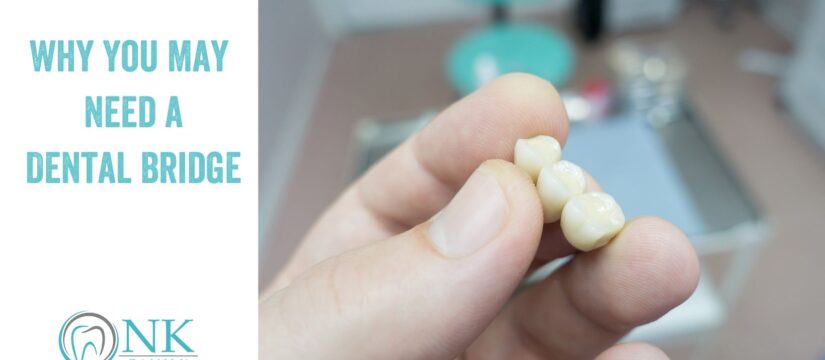
If you are missing a tooth — or your dentist tells you that one of your teeth needs to be extracted — you will most likely have one of two options for replacing it: an implant, or a dental bridge. As our blog post — “All About Dental Bridges” — covers, your dentist will typically discuss the type of restoration that is best for your mouth on both a functional and aesthetic level before removing a tooth. If one or more teeth are lost due to periodontitis or injury, your dentist will evaluate whether you’re a good candidate for a bridge, or need another kind of restoration.
As described by Washington State Prosthodontics, “A bridge is composed of two crowns, one on either side of the gap where the missing tooth is located. These crowns, known as abutment teeth, are used to anchor the bridge. A false tooth or teeth (known as pontics) lie between these abutments.”
Pontics can be made from a variety of materials — such as gold — but they’re typically made from porcelain to aesthetically blend in with your natural teeth.
Advantages of a Dental Bridge
Although dental implants are increasing in popularity, there are reasons why your dentist may recommend a bridge, or you may prefer it over an implant. Whereas a dental implant requires oral surgery and drilling into the jawbone in order to implant a titanium post that will anchor the pontic restoration, receiving a traditional bridge is no more invasive than getting a dental crown. Compared with the multi-stage (and multi-month) process that a traditional implant entails, getting a dental bridge involves practically no downtime.
Moreover, a traditional dental bridge is less costly than an implant. If budget is a concern and you’re an appropriate candidate, a bridge may be the better option.
Overall advantages of a dental bridge include the following:
Maintains the natural shape of your face — Replacing a missing tooth (or teeth) with a bridge prevents the sunken-in appearance that quickly occurs in the absence of the tooth.
Prevents surrounding teeth from shifting position in the mouth — When a tooth is missing, nearby teeth eventually move toward the gap, which also causes the other teeth to shift position, creating misalignment – which adversely affects oral health and facial aesthetics. A bridge keeps the surrounding teeth in place.
Maintains the ability to properly chew food and/or speak — A missing molar or premolar makes chewing more difficult, while a missing tooth closer to the front of the mouth may affect your speech. Not being able to chew properly allows larger food particles to enter the digestive tract — causing digestive problems such as gas, bloating, constipation, food reactions, headaches and lowered energy levels. A bridge maintains the healthy function of your teeth — and thereby your overall health — as well as your ability to speak clearly.
Main Types of Dental Bridges
There are four main types of dental bridges. Being familiar with the specifics of each type will help you have a better informed conversation with your dentist in considering your options.
Traditional bridge — This type consists of two crowns on either side of the missing tooth, with a pontic between the crowns. It is usually fashioned of porcelain that has been fused to metal or a dental-grade ceramic material.
Cantilever bridge — This type is an option when it isn’t possible to anchor the bridge to a natural tooth on either side of a gap. Situations that are most appropriate for a cantilever bridge are those where there is only one anchor tooth on one side of the gap — such as with the last tooth in the back of the mouth.
Maryland bonded bridge — This type is also known as a resin-bonded bridge, or just a Maryland bridge. It can be made from a variety of materials — including porcelain, porcelain that has been fused to metal, or even plastic with an underlying metal and porcelain framework. The porcelain or metal wings are usually fused to your existing teeth on just one side of the bridge. As with a traditional bridge, a Maryland bridge can only be used when you have a natural tooth on each side of the gap caused by the missing tooth or teeth.
Implant-supported bridge — This may seem somewhat confusing, as we’ve so far been covering dental bridges and implants as two separate categories of restorations. However, this can be an option when three or more teeth in a row are missing. The pontics are secured by an implant at each end of the bridge.
Typical Dental Bridge Procedure
The process of getting a dental bridge can involve two or three appointments. The basic process is as follows:
Local anesthesia and abutment teeth preparation — During your first visit, your dentist will administer a local anesthesia to numb the area for treatment, then reshape the abutment teeth. Part of the enamel and dentin will be removed so the crown can fit over each abutment tooth.
Impressions — Your dentist will take impressions or a digital scan of your teeth. This will be sent to a dental laboratory, which will use the mold or scan as a model to create your bridge. Your dentist will fashion a temporary bridge to protect the exposed areas while the lab fabricates your bridge.
Bridge placement — During your second visit, your dentist will remove the temporary bridge and place the permanent bridge, checking carefully to be sure it fits you comfortably, and making any adjustments, if necessary. Your dentist will then use a temporary cement to affix your bridge so you can “test drive” it for a couple of weeks to ensure it’s a proper fit, and that you have no problems chewing. If all is well, your bridge will be permanently cemented during the third visit.
How to Care for Your Dental Bridge
A dental bridge is a strong restoration designed to withstand the normal use of daily life. However, as we always advise, avoid biting down on hard foods, don’t chew ice and don’t use your teeth as a bottle opener! Such actions can damage bridges and crowns as well as your natural, unadorned teeth.
In addition, a bridge requires special care to maintain optimum oral health. Plaque-causing bacteria can grow under the pontic, leading to periodontal (gum) disease and decay of the abutment teeth. For this reason, your regular routine of brushing at least twice a day and flossing once daily needs to be supplemented by taking care to floss under the pontic. Clean under the bridge with a super floss, a floss threader or an interdental brush. A water flosser can also be used. Our blog post — “How to Floss Your Teeth Like a Pro” — provides detailed instructions on using a floss threader.
As for brushing, use a soft-bristle toothbrush, and fluoride toothpaste. Avoid whitening pastes, as they can be too harsh and damage the bridge.
And, need we mention the importance of scheduling (and keeping) regular six-month dental check-ups? At NK Family Dental, check-ups include a professional cleaning using specialized dental tools to eliminate difficult-to-remove plaque on the teeth and below the gum line, followed by polishing the teeth to remove surface stains. We also examine the mouth for any signs or symptoms of tooth decay or gum disease, and check on dental restorations to make sure that they are holding up well.
The Take-Home Message
A dental bridge can be the ideal solution to restore one or more missing teeth, but as previously mentioned, the decision should ultimately be reached by a discussion between you and your dentist. Taking proper care of your bridge will help ensure optimum oral health, as well as extend its useful life for many years — perhaps decades — to come!
At NK Family Dental, it is our mission to provide the highest quality and most compassionate oral care to our Chicago patients, including both dental and periodontal services. Our practice is trusted for advanced oral surgery procedures and comfortable root canal treatment.
Our team of experienced, dedicated dental professionals will help address your oral health concerns, and determine the best solution for you based on your individual situation. We strive to identify treatment options that fit your needs.
Our dental specialists include our general dentist, Dr. Nilofer Khan, our endodontist, Dr. Sabek, and our periodontist, Dr. Amir Danesh. Dr. Danesh is a board-certified periodontist and Diplomat of the American Board of Periodontology. He has contributed to the publication of two books, as well as published over 20 papers in prestigious dental research journals.
We serve the neighborhoods of Logan Square, Bucktown, Humboldt Park, and Wicker Park with the dedication that’s earned us the reputation as the Best Dentist in Chicago!
We understand that the main concern you may have is cost, which is why we accept all major PPO plans for dental insurance and also offer our in-house dental plan. Please see our financing page for more information.
Schedule your visit through ZocDoc, or contact us directly. We look forward to treating you soon!
